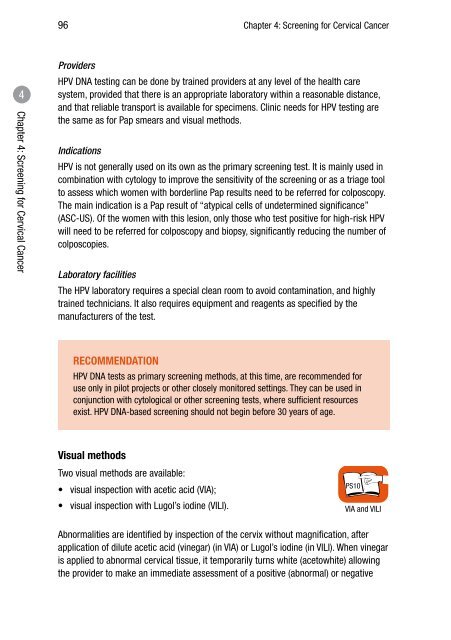CHAPTER 4: SCREENING FOR CERVICAL CANCER
CHAPTER 4: SCREENING FOR CERVICAL CANCER
CHAPTER 4: SCREENING FOR CERVICAL CANCER
Create successful ePaper yourself
Turn your PDF publications into a flip-book with our unique Google optimized e-Paper software.
96Chapter 4: Screening for Cervical Cancer4Chapter 4: Screening for Cervical CancerProvidersHPV DNA testing can be done by trained providers at any level of the health caresystem, provided that there is an appropriate laboratory within a reasonable distance,and that reliable transport is available for specimens. Clinic needs for HPV testing arethe same as for Pap smears and visual methods.IndicationsHPV is not generally used on its own as the primary screening test. It is mainly used incombination with cytology to improve the sensitivity of the screening or as a triage toolto assess which women with borderline Pap results need to be referred for colposcopy.The main indication is a Pap result of “atypical cells of undetermined significance”(ASC-US). Of the women with this lesion, only those who test positive for high-risk HPVwill need to be referred for colposcopy and biopsy, significantly reducing the number ofcolposcopies.Laboratory facilitiesThe HPV laboratory requires a special clean room to avoid contamination, and highlytrained technicians. It also requires equipment and reagents as specified by themanufacturers of the test.RECOMMENDATIONHPV DNA tests as primary screening methods, at this time, are recommended foruse only in pilot projects or other closely monitored settings. They can be used inconjunction with cytological or other screening tests, where sufficient resourcesexist. HPV DNA-based screening should not begin before 30 years of age.Visual methodsTwo visual methods are available:• visual inspection with acetic acid (VIA);• visual inspection with Lugol’s iodine (VILI).PS10VIA and VILIAbnormalities are identified by inspection of the cervix without magnification, afterapplication of dilute acetic acid (vinegar) (in VIA) or Lugol’s iodine (in VILI). When vinegaris applied to abnormal cervical tissue, it temporarily turns white (acetowhite) allowingthe provider to make an immediate assessment of a positive (abnormal) or negative
















